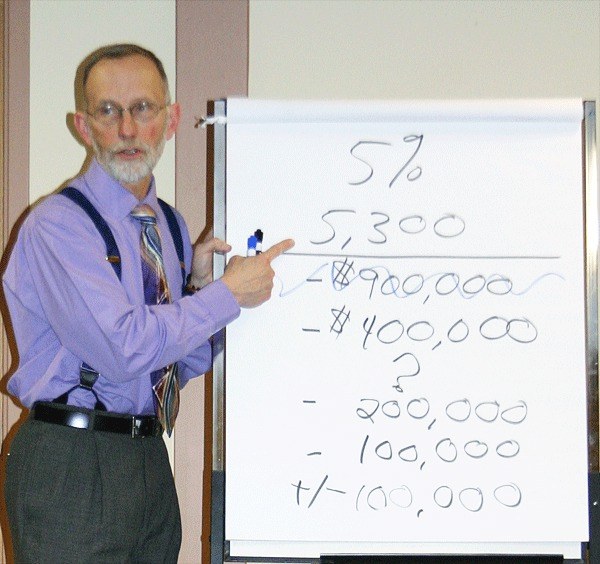With one of the lowest local levies in the state, the Oak Harbor School District hopes the community will support an increase to the levy. The board wants to hear the public’s opinion as they begin budgeting for next school year in a series of Monday night meetings.
In the first meeting Feb. 21, Superintendent Rick Schulte gave a current budget status report. The district’s revenue of $48.15 million is a little less than budgeted but higher than the expenditures, which fall at $48.10 million.
For the 2012-2013 year, Schulte said the district has estimated that enrollment will remain at 5,300, as it has for the past three years.
As they begin budgeting, however, uncertainty is everywhere. Gov. Chris Gregoire’s threat to cut Levy Equalization money is still a worry and rising fuel prices will affect transportation funding. Schulte said they know Federal Impact Aid funding will be down a few hundred thousand dollars this year because the district will be receiving the funds from three years ago, which were less than the district is paid now due to how the government allocated funds that year.
“Everybody is used to dealing with the uncertainty and it’s no fun,” said school board member Peter Hunt. The budget has to be completed before the district knows its enrollment and funding numbers for certain. However, as in the past, professionals like Schulte get the district through the process, Hunt said.
The current levy, including Levy Equalization money, which is the state levy match, yielded $4.2 million in 2012. That funds approximately 20 teachers, 20 fulltime-equivalent classified staff and $2 million for materials, supplies and operations.
The tax rate of 0.92 is one of the smallest in the state; the state average is $2.54. That means the average Washington state student receives nearly three times as much local funding as an Oak Harbor student.
Oak Harbor is at 29.8 percent of the legal levy limit. The majority of school districts in the state are already at the legal limit. If Oak Harbor increased its levy to the highest legal limit, it would receive approximately $11.4 million.
Over the past five years, the district has been making sizable cuts, including cutting 30 teachers, librarians and counselors, cutting 30 minutes from the middle school day, cutting maintenance, grounds and custodial staff and cutting back on athletics by trimming assistant coaches and some tournaments. Staff took a 1.9 percent wage and salary cut and furlough days. The after-school activity bus that allowed after-school tutoring was cut, along with midday busing for everyday kindergarten. The district hasn’t purchased new textbooks for three years.
“We’re making the same cuts that other people are but we started at a lower level,” Schulte said, adding that some of the results of these cuts will become more apparent over time, like the elimination of preventative maintenance and grounds staff.
However, the district has been successful in many ways. Massively remodeling the high school and building the stadium raised school and community spirit, students win national competitions in computer-aided drafting, culinary, marketing and more, the high school offers a wide variety of classes and the levy funds elementary art and physical education, which not every community offers, Schulte said.
“In some respects, we’re doing a lot better than we should be doing with the resources we have available,” Schulte said.
However, increasing the levy to just below the state average would fund so much more at the schools, Schulte said.
Schulte laid out what the district could have if its funding was equal to that of neighboring districts.
For example, $700,000 per year would buy new textbooks and keep them updated and an additional $500,000 per year would keep technology updated. Special education could use $500,000 to re-hire staff and instructional assistants cut after federal stimulus money ran out, and to buy new technology.
To restore two grounds staff, two maintenance staff and four custodians, as well as replace equipment and vehicles that haven’t been replaced in years, Schulte would allocate $700,000 to maintenance and grounds.
Schulte said capital projects could use $500,000 and athletics and activities, which are solely funded by the levy and Impact Aid, could use $700,000. To buy back everyday kindergarten and the activity bus and to deal with rising fuel costs, $500,000 needs to be allocated to transportation.
In order to save middle school assistant principals and high school dean positions, administration needs $400,000. To restore the 1.9 percent pay cut and hours cut for classified staff, $700,000 is needed.
For the middle schools, $800,000 would restore the 30 minutes cut from the day and hire 10 out of 30 teachers who were cut.
This would add up to $6 million. With the addition of Levy Equalization and the current levy, the district would receive $11 million, “a little bit less than average,” Schulte said.
“I’m not saying we’re going to do everything on this,” Schulte said. “At this point, we have to cross things off.”
At future meetings, the board will address the issue of: “What are our kids going to do without if we don’t do these things?” Schulte said.
The school board asks the community to provide their input at these meetings, which will be Mondays, March 5, March 19, April 16 and April 23 at 6 p.m. in the district office, located at 350 S. Oak Harbor St.
“The more input we have, the better it will be,” Schulte said.
For information call 279-5000.



